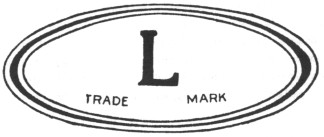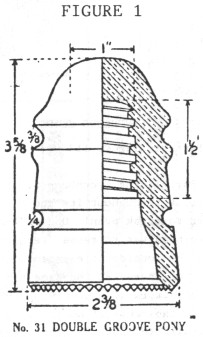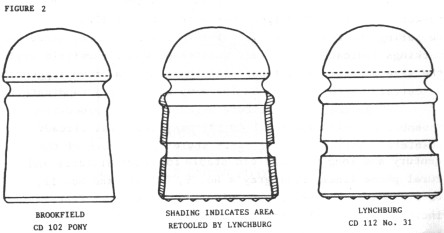Varieties of Lynchburg Glass, Part II
by Dennis Bratcher - Oklahoma City, OK
Reprinted from "Crown Jewels of the Wire", August 1986, page 27
Part 2: The CD 112
As noted in Part 1, the Lynchburg Glass Company struggled to show a profit
throughout its short history, in fact, struggled just to break even! One of
Lynchburg's tactics for reducing overhead was to reuse secondhand insulator
molds thus eliminating the considerable expense of designing and tooling new
molds. Of course at the same time this practice provided us collectors with
something to do!

One problem in the reuse of molds was the suitability of the styles of the
available molds for the current market demands. Obviously, Lynchburg was not
going to have ready access to state-of-the-art molds and designs from Hemingray
or Whitall-Tatum, so the company had to make-do with the molds they could
obtain. One of the best examples of their creativity in re-tooling available
molds to meet market demands was the Lynchburg No. 31, CD 112.
The Lynchburg No. 31, although assigned the CD number 112 and broadly fitting
into this design category, is actually a unique design created in the Lynchburg
shops. The style exhibits features of both CD 112 and CD 113 and comes closest
in design to the early Hemingray No. 12, CD 113, although minus the top lip on
the upper wire groove. In fact, on a mailer sent by Lynchburg to prospective
customers to illustrate their line of insulators, an illustration of a Hemingray
No. 12 was used to depict the Lynchburg No. 31. The illustration, as are most in the
mailer, was obviously taken from a Hemingray catalog (a 1921
Hemingray catalog was in the Lynchburg records acquired by Mr. Woodward; see
figure 1).

Illustration of the No. 31
from a Lynchburg Mailer
Since the Gayner company had never produced the double-groove pony
style, and therefore Mr. Gayner could not supply these molds, Lynchburg had to
either acquire or manufacture molds for this style. With the specific configuration
of the No. 31 being unique to Lynchburg, it could be concluded that Lynchburg
manufactured the molds themselves. But the key to their true origin is the crown
top markings which appear on all Lynchburg No. 31s: either numbers, often
backwards, such as "01 or "2" or letters such as "XO"
(or "OX"). Apart from mold numbers, Lynchburg did not use shop
markings on any insulators. The only crown markings used by Lynchburg were the
occasional placement of the oval trademark there (CD 162, CD 121, CD 154) and the style numbers of CD 281 and CD 306. This fact
suggests that the molds are secondhand and the crown markings, especially the
"X0", immediately suggests a Brookfield origin for the molds since this was a
common shop marking used by Brookfield. But Brookfield, even with their three
major varieties of CD 112s (cf. Cranfill & Kareofelas, The Glass
Insulator,
1973, p. 39) and several minor variations, never produced a CD 112 like the
Lynchburg No. 31.
While it is possible that Lynchburg acquired CD 112 Brookfield molds and then
altered them into the Lynchburg design, this is highly unlikely. There would be
little reason for Lynchburg to go to the expense of altering a CD 112 mold in
the minor ways in which the Lynchburg No. 31 differed from the Brookfield No. 31.
It would have been much more economical to simply re-cut the Lynchburg logo over
the Brookfield embossing as was done with the No. 36, CD 162 molds acquired from
Brookfield.
The conclusion at this point is that Lynchburg re-worked another Brookfield
style into the CD 112, No. 31. Comparing the top (crown) 1/3 of the Lynchburg
mold, since the markings indicate it was left unaltered, with Brookfield styles,
the size and nearly hemispherical shape of the crown suggests a certain variety
of the CD 102 pony as a likely candidate.
By the time Lynchburg began insulator production in November of 1923, the
small CD 102 pony style was already obsolete. While a popular early style to the
turn of the century and long a Brookfield staple for short distance and rural
phone lines, Hemingray's No. 9, CD 106, and No. 12, CD 113, were increasingly
popular (due to several factors including Brookfield's war-era problems). By the
time Brookfield ceased production in 1920 the CD 106 and CD 113 were the
standard short line phone insulators. When Lynchburg laid their hands on the Brookfield
molds for the CD 102 they had an obsolete insulator which was
virtually unsaleable. Since they already had an insulator from the Gayner molds
to compete with Hemingray's No. 9 (Lynchburg No. 10, CD 106), they needed a
double groove pony to compete with Hemingray's popular No. 12. So, I suggest,
the Brookfield CD 102 molds were machined to new specifications which yielded
the Lynchburg No. 31, CD 112.
A careful examination of the No. 31 and a comparison with some Brookfield CD
102s supports this conclusion. The slope of the sides of the two are nearly
identical and measurements of the unusually thick middle section of the No. 31 are exactly
what would be required for the CD 102 mold to be retooled to allow the bottom
wire groove on the CD 112 (figure 2). Also an examination of the base of
Lynchburg No. 31s shows that the sides of the insulators extend between 1 and
1.5 mm past the base rim all around the base, a result of the sides of the mold
being machined out into the wider style.
Too, the many minor variations of the Lynchburg No. 31, mostly in the width
and shape of the upper wire groove lip, the size and shape of the crown, and the
height of the insulator (rarely are two different Lynchburg No. 31 molds
identical) would be consistent both with the wide variety of Brookfield CD 102s
and the fact that modifications were being made to existing molds. The
conclusion, then, is that the Lynchburg No. 31, CD 112, is a result of the
modification of the Brookfield Pony CD 102.

The lettering on the Lynchburg No. 31 is, for Lynchburg, amazingly
consistent. The front embossing is usually 7.5 mm high and reads LYNCHBURG No.
31 while the reverse embossing is the familiar "L" in a large oval (13
x 19 mm) followed by the mold number, then MADE IN / U.S.A. in two lines. I know
of mold numbers through nine, although I suspect there may be more. I know of no
embossing errors on the No. 31.
There are two kinds of drip points found on the No. 31. The more common one
is small and cone-shaped slanting slightly inward which would indicate that the
points were added to an originally smooth-based mold. There are always 28 and
are uniform in size. A much scarcer type is a larger drip point that is
cylindrical at the base and rounded at the tip. There are usually only 27 of
these points and are frequently of slightly varying sizes.
I have never seen nor heard of a smooth base No. 31 and doubt if one was ever
produced by Lynchburg. The primary competition was the Hemingray No. 12 which Hemingray widely advertised with drip points as a primary feature.
The Lynchburg No. 31 does not occur in a wide variety of colors due to the
fact that it was only in production a total of eleven weeks (and not every day
in those weeks). The most common color that I have seen is a light sagey
green-aqua. It also occurs in green, a darker near-emerald green and yellow-green as well as crystal clear. I have reports of clear with a pinkish tint and
clear with a smoke tint but I have not been able to confirm these. It also
occurs in a light aqua, although I have not seen the bright sparkling blue-aqua
common to other Lynchburg styles.
The number of No. 31s sold by Lynchburg in such a short time (175,000)
attests to their ingenuity in the modification of obsolete molds.
| 